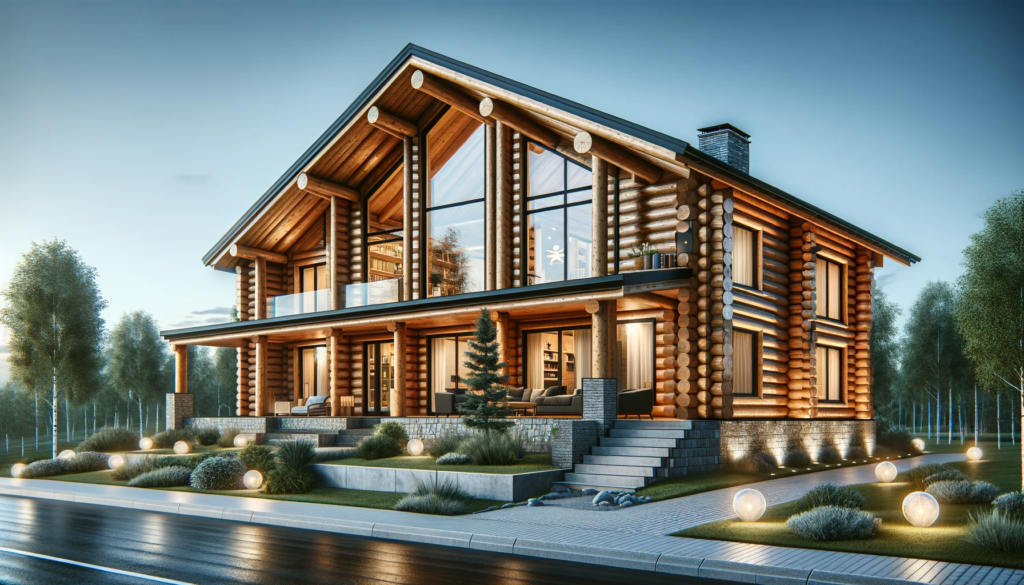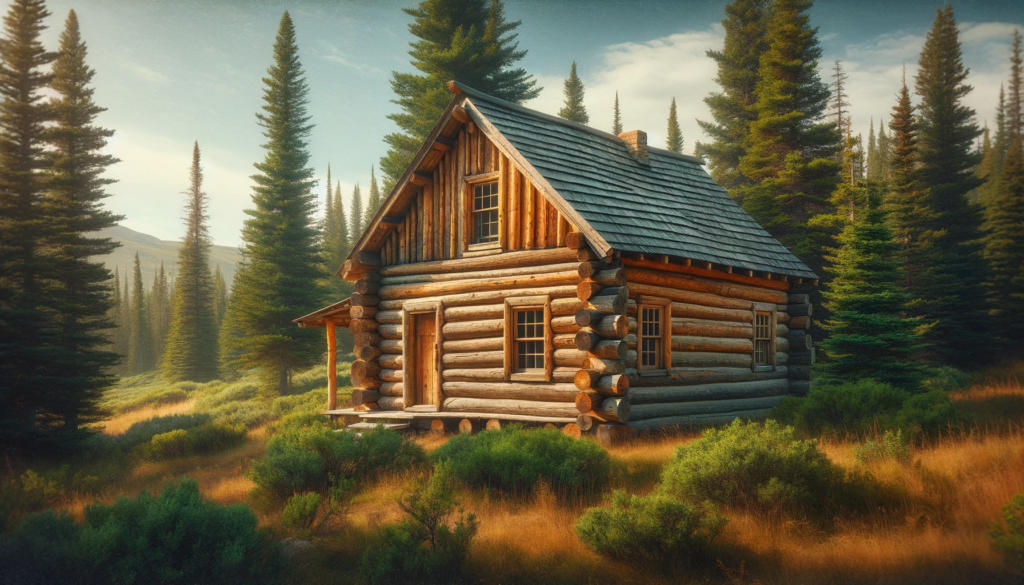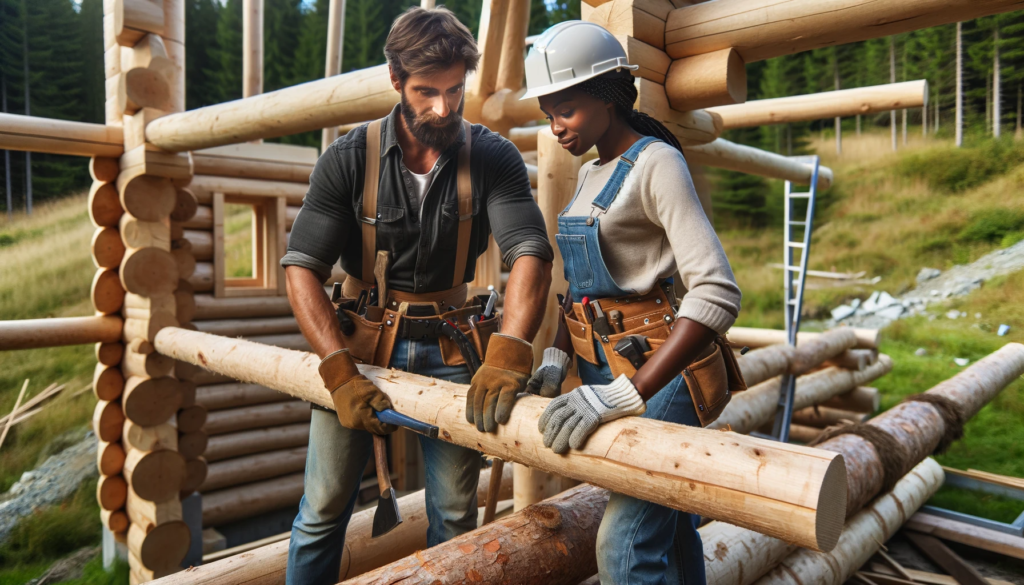The phrase ‘horizontal log construction’ evokes visions of quaint, woodland cabins, echoing an era of simplicity. This architectural style, transcending its historical origins, continues to captivate and serve practical purposes in today’s world. Horizontal log construction, true to its designation, entails layering horizontal logs to forge various structures, from rudimentary shelters to elaborate dwellings.
Imbued with historical significance, this building approach has deep-seated origins in the chronicles of architectural development. It emerged as a functional solution for early settlers and native groups in diverse locales, notably in the densely wooded areas of Scandinavia, Eastern Europe, and North America. Over the centuries, horizontal log construction has evolved and persisted, now standing not just as a tribute to our forebears’ resourcefulness but also as a feasible, eco-friendly choice in modern-day architecture.
The progression of horizontal log construction over the ages showcases an intriguing blend of necessity, environmental factors, and cultural influences. Spanning from the basic log cabins fashioned by early frontiersmen to the contemporary log houses speckling suburban areas, each edifice narrates a tale of adaptation and ingenuity. Throughout this article, we delve into the complex realm of horizontal log construction, examining its historical lineage, its relevance in present-day building, and its potential trajectory amidst the dynamic field of architectural design.

Defining Horizontal Log Construction
Horizontal log construction, a method of building, is distinguished by arranging horizontal logs on top of each other to create a structure’s walls. This approach, apparently straightforward, entails a series of detailed procedures and careful considerations for maintaining both structural soundness and visual attractiveness.
Fundamentally, horizontal log construction revolves around the careful selection and preparation of suitable logs. These logs, usually obtained from evergreen trees such as pine, spruce, or cedar, are selected based on their straightness, consistency, and resistance to deterioration. Once harvested, the logs undergo debarking and, if required, are treated to avert decay and insect damage. The actual construction begins with establishing a robust foundation, followed by horizontally stacking the logs. Notching the logs at their ends, a meticulous task, ensures they interlock with adjacent logs, forming a robust seal. This technique, referred to as “corner notching,” is vital for the building’s stability and varies stylistically, ranging from the Scandinavian saddle notch to the dovetail notch prevalent in Eastern Europe.
While the fundamental principle of horizontal log construction is centered on utilizing natural logs, contemporary developments have brought about variations. Present-day builders may opt for milled logs, characterized by uniformity in shape and size, or choose handcrafted logs for a more authentic, rustic look. The selection of logs directly influences the appearance, insulation quality, and overall strength of the finished structure. The evolution of tools used in log construction has also been significant, moving from traditional implements like axes and adzes to modern chainsaws and precision cutting devices, enhancing both accuracy and efficiency in the construction process.
Historical Significance
The historical lineage of horizontal log construction spans as vast and varied as the forests that supplied its essential material. This architectural style bears a legacy that mirrors the ingenuity and tenacity of ancient human communities.
Tracing its roots back several thousand years, some of the earliest instances of horizontal log construction emerged in the dense woodlands of Northern Europe and Siberia, blessed with an abundance of timber. However, this building technique wasn’t limited to these areas. It independently surfaced in different corners of the globe, including Asia and North America, especially among native populations who leveraged the plentiful forest resources for constructing shelters.
Across different cultures and landscapes, distinct adaptations in log construction methods evolved. In the Scandinavian region, for example, complex notching techniques were developed to withstand severe winter conditions, whereas in Eastern Europe, architectural styles progressed to include larger and more ornate buildings. In North America, the humble log cabin came to symbolize the pioneering spirit, embodying the method’s practicality and straightforwardness in the rugged frontier settings. These variations in regional styles led to a diverse spectrum of designs and techniques, each tailored to fit the local environmental conditions, available tools, and cultural preferences.
Over time, the progression of horizontal log construction stands as evidence of its versatility and lasting charm. From the modest, single-room dwellings of the early settlers to the grandiose log lodges and sophisticated country homes of later years, this technique has adapted to meet evolving demands and technologies. The application of logs in construction transitioned from being a necessity to a preferred choice, particularly as the advent of industrialization introduced new building materials and methods.

Modern Applications
Nowadays, horizontal log construction transcends its historical role, emerging as a vibrant and adaptive architectural form that resonates with contemporary preferences and demands. It surpasses its traditional applications, marrying the allure of historical styles with the practicalities and design trends of the modern era.
In the realm of current architectural design, log homes have become increasingly sought after for their fusion of traditional rustic appeal and contemporary features. These dwellings showcase the timeless aesthetic of log construction, augmented by modern enhancements such as advanced insulation, energy-efficient windows, and cutting-edge facilities. Architects and builders are innovatively combining logs with other materials like glass, steel, and stone, crafting distinctive and varied designs that cater to diverse preferences.
Extending beyond just residential use, horizontal log construction also finds its place in commercial and leisure-oriented buildings, including resorts, lodges, and even corporate structures. These buildings often leverage the organic beauty of logs to foster an inviting, cozy environment that harmoniously integrates with the natural setting. This approach is particularly noticeable in tourist hotspots, where the architecture is designed to enhance the scenic beauty of the location.
Furthermore, the evolution in construction methodologies has broadened the scope of possibilities with horizontal log construction. The use of engineered logs, meticulously cut and treated to ensure longevity, has streamlined the building process, making it more efficient and eco-friendly. Advances in building regulations and design technology have empowered architects to explore new frontiers in log construction, leading to the creation of buildings that are not only aesthetically pleasing but also robust and durable.
Sustainable Practices and Environmental Impact
Environmental sustainability and responsible stewardship form the cornerstone of horizontal log construction, mirroring the increasing awareness of the ecological ramifications associated with building materials and techniques.
The ecological viability of log construction hinges largely on the timber’s origin. Adhering to sustainable forestry methods, such as selective logging and the careful management of woodlands, is vital. These practices strike a delicate balance between meeting construction demands and conserving forest habitats. Utilizing timber from responsibly managed forests helps builders reduce the environmental impact of their projects.
The environmental aspects of log harvesting are significant. Harvesting methods that are considerate of the environment help mitigate effects on wildlife habitats, prevent soil erosion, and preserve the diversity of forest ecosystems. Additionally, wood’s ability to sequester carbon – capturing and storing carbon dioxide within the timber for the structure’s lifetime – plays a crucial role in combating climate change.
Today’s log buildings go beyond mere aesthetic appeal, increasingly integrating energy-efficient features and environmentally friendly innovations. This includes the installation of highly insulated windows, doors, and roofing, which align with logs’ innate insulation qualities, thereby lowering heating and cooling energy demands. The application of non-toxic treatments and finishes on logs further underscores the eco-conscious nature of these constructions.
The durability of log structures also contributes significantly to their environmental impact. A well-built log structure can endure for many generations, reducing the frequency of renovations or reconstructions. Life cycle assessments of log buildings typically reveal a reduced environmental footprint over time, especially when compared to traditional construction, owing to their long-lasting nature and the use of natural materials.

Technological Advancements
Technological progress has profoundly transformed the realm of horizontal log construction, significantly boosting the efficiency and expanding the capabilities of this classic construction technique.
Cutting-edge technology has introduced unparalleled precision into the process of log construction. The use of Computer-Aided Design (CAD) software empowers architects and builders to meticulously plan and visualize log structures with exceptional accuracy. This level of precision is further carried into the cutting and shaping of logs, where Computer Numerical Control (CNC) machines are used to produce uniformly shaped logs, guaranteeing a perfect fit and robust structural integrity.
Advancements in preservation methods have markedly increased the lifespan of log structures. Modern treatments and finishes offer superior protection against moisture, insects, and decay, thereby prolonging the life of these structures while preserving their inherent beauty and strength.
Innovative technologies have given rise to new construction systems and techniques within the field of log building. These advancements include engineered log systems, which provide enhanced structural stability and better insulation. Moreover, hybrid construction methods that combine logs with other materials such as glass, steel, or traditional framing, facilitate increased design versatility and building efficiency.
Technology also plays a crucial role in enhancing the sustainability of log construction. From the use of advanced systems for tracking sustainably sourced logs to the incorporation of eco-friendly insulation and energy solutions in log homes, technological innovations are instrumental in reducing the environmental impact of log construction.
Conclusion
Delving into the world of horizontal log construction takes us on a journey rich in historical, artistic, and scientific narratives. This timeless method of building, with deep historical roots, remains relevant and appealing in today’s world. Spanning from traditional rustic cabins to modern log homes and commercial buildings, horizontal log construction represents a distinct fusion of natural allure, eco-conscious practices, and innovative architectural design.
The advantages of log construction, ranging from its visual appeal to its inherent insulating capabilities, are met with challenges that call for responsible forestry and ongoing maintenance. However, the advancing fields of technology and sustainable development are providing effective solutions, improving the efficiency, durability, and eco-friendliness of log structures.
Looking ahead, horizontal log construction symbolizes the enduring bond between humanity and nature, and our capacity for adaptation and innovation. This construction style not only reflects our historical journey but also offers a vision for a sustainable and aesthetically rich architectural future. By integrating historical insights with contemporary advancements, horizontal log construction continues to present valuable and lasting solutions in the dynamic sphere of building and design.